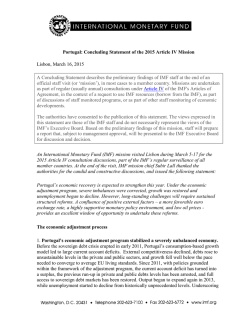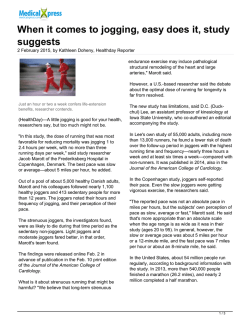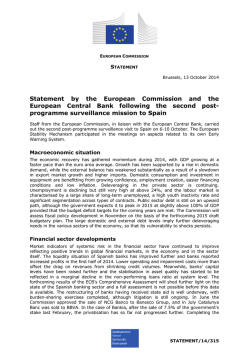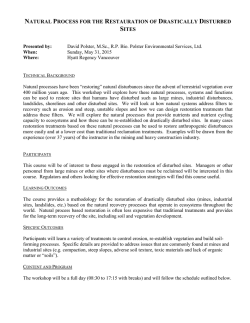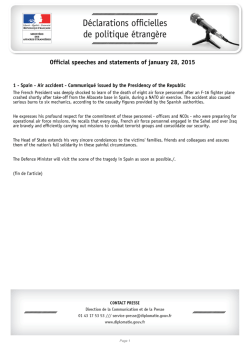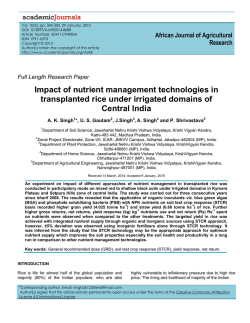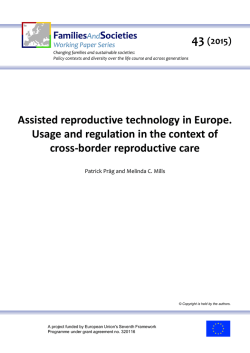
Download PDF: "PACE Action Plan"
PACE Action Plan Patient Access to Cancer care Excellence Introduction We are at a pivotal point in the fight against cancer. Much progress has been made through continuous innovation, but the progress is not fast enough and does not reach every patient. In 2012, Lilly Oncology launched a global network to help improve the cancer-policy environment, in which decisions are made on the development of new treatments and patients’ access to care. Called PACE, or Patient Access to Cancer care Excellence, the Lilly Oncology initiative aims to encourage public policies and healthcare decisions that speed the development of new medicines, assure cancer treatments respond to the needs and qualities of individual patients, and improve patient access to the most effective cancer care. PACE engages with a Global Council of leading experts from numerous countries and stakeholder groups to make sure that we stay true to our patient focus and that we do our best to add value rather than duplicate what already exists. From the start, we promised to put the interests of patients at the center of our efforts and to work collaboratively with patient advocates, cancer care providers, regulators, political leaders, and health-care payers alike. Therefore, PACE and its Global Council established a set of goals that this effort could champion and implement in the coming years. P A C E A C T This document presents the PACE Action Plan, structured around four sets of goals: • Faster Continuous Innovation • Greater Patient Access • Stronger Patient Voice • Fuller Understanding PACE is active in a growing group of countries in the Americas, Asia, and Europe. Driven by what we are learning from the public about patient needs and viewpoints, our toolkit of collaboration includes: surveys and qualitative opinion research; policy research; public-policy initiatives; educational programs and events; measurement tools, and communications efforts in traditional and social media. This is our Action Plan for moving forward. Learn more about PACE and connect with us online at: www.pacenetwork.com www.pacentworkusa.com www.pacenetwork.de www.pacenetwork.co.uk @pacenetwork facebook.com/PACENetworkUSA www.youtube/PACENetworkUSA I O N P L A N GOAL Faster Continuous Innovation Research and development against cancer accelerate and encourage treatments that are integrated with other forms of care, closely tailored to individual patients, and effective at earlier stages of the disease. Action Steps • Develop and share patient-friendly tools, information, and practices that could significantly increase patient participation in cancer clinical trials. • Strengthen efforts to reform clinical research—including new trial designs, recognition of patient-reported outcomes, testing of combination therapies, better alignment of regulatory systems across borders, and other improvements. • Develop and share the PACE Continuous Innovation Indicators™ as a rigorous, flexible tool to measure the evidence of progress against specific cancers—with the additional goals of helping decision makers to visualize progress against cancer, identifying unmet needs, and informing cancer-policy reforms that could speed innovation. • Promote an open and trusting environment for R&D collaboration among industry researchers, academia, physicians, and patient advocates. P A C E A C T I O N P L A N GOAL Greater Patient Access More and more patients gain access to the cancer care and treatment that will be most effective for them. Action Steps • Sensitive to the cultures and health-care systems of different countries, build coalitions to preserve and ultimately expand patient access to the most effective cancer care. • Help to shape and implement patient-access and health-care payment reforms that stress the holistic value of cancer treatments. • Drive research to illuminate how the value of individual cancer treatments can improve over time in clinical practice. • Promote efforts to meet the broader needs of patients with cancer, beyond medical interventions. P A C E A C T I O N P L A N GOAL Stronger Patient Voice The voices of patients are heard and acted upon in decisions on the development, assessment, use, and payment of new treatments for cancer. Action Steps • Encourage criteria and measures of value that recognize outcomes important to patients in decisions on access to cancer treatments. • Support the adoption of values and standards across geographies for patient and public involvement in Health Technology Assessment (HTA). • Widely share the live and online Medicine Evaluation Educational Training (MEET and eMEET) curricula among patient-advocacy leaders, to help build understanding of HTA processes and the means by which patients can influence them. • Provide patient advocates access to the PACE Continuous Innovation Indicators™ as a tool for illuminating progress, unmet needs, and potential policy reforms against cancer. P A C E A C T I O N P L A N GOAL Fuller Understanding Myths about the nature of cancer and progress against cancer give way to more accurate understandings, which in turn improve the quality of health-policy decisions. Action Steps • Conduct and widely share opinion research on cancer issues involving patients and the public. • Offer the PACE Continuous Innovation Indicators™ and other materials to better explain the contributions of step-wise improvements in cancer care. • Use online and social-media platforms to permit wide dissemination of information and real-time responses to cancer-policy debates. • Drive high-profile public discussions of cancer progress, to January 2015 - V4.2 encourage understanding of the underlying scientific and policy challenges along with reforms that could improve the speed and patient-centeredness of innovation. P A C E A C T I O N P L A N
© Copyright 2025
